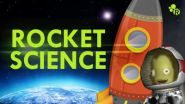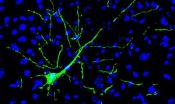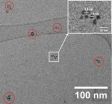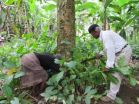(Press-News.org) WASHINGTON, August 4, 2014 — This week, Reactions is blasting off with an episode that's all about rockets. Featuring Doane College Postdoctoral Fellow Raychelle Burks, Ph.D., we examine the chemistry of solid and liquid propellants, orbital maneuvering and the "ride-able explosion" that is a rocket launch. You can "launch" the video at: https://www.youtube.com/watch?v=Yqiq2lQrqGI.
INFORMATION:
Subscribe to the series at Reactions YouTube, and follow us on Twitter @ACSreactions to be the first to see our latest videos.
The American Chemical Society is a nonprofit organization chartered by the U.S. Congress. With more than 161,000 members, ACS is the world's largest scientific society and a global leader in providing access to chemistry-related research through its multiple databases, peer-reviewed journals and scientific conferences. Its main offices are in Washington, D.C., and Columbus, Ohio.
To automatically receive news releases from the American Chemical Society, contact END
It's not rocket science. Oh wait, it is
2014-08-04
ELSE PRESS RELEASES FROM THIS DATE:
NASA sees Tropical Storm Bertha leaving the Bahamas
2014-08-04
Tropical Storm Bertha took a "vacation" in the Bahamas on August 3 and NASA's Terra satellite captured an image of the storm that appeared be centered over "Crooked Island."
On August 2, before Bertha visited the Bahamas, the western half of the storm passed over Puerto Rico. A visible image captured by NASA's Terra satellite showed Bertha's clouds stretched from Puerto Rico east, over the British Virgin Islands. NOAA's National Weather Service office in San Juan, Puerto Rico reported 1.36 inches of rainfall from Bertha on August 2.
On August 3 at 15:35 UTC (11:35 a.m. ...
New information on transcranial ultrasound therapy
2014-08-04
A recent study completed at the University of Eastern Finland provides new information on the limitations and potential new directions for the future development of transcranial ultrasound therapy. Active research is taking place in the field of transcranial ultrasound therapy, which in the future can potentially be applied to the treatment of brain tumours and targeted drug delivery. The therapy modality has already been successfully applied to the treatment of neuropathic pain disorder and essential tremors. The benefits of transcranial ultrasound therapy include minimal ...
Implanted Neurons become Part of the Brain
2014-08-04
Scientists at the Luxembourg Centre for Systems Biomedicine (LCSB) of the University of Luxembourg have grafted neurons reprogrammed from skin cells into the brains of mice for the first time with long-term stability. Six months after implantation, the neurons had become fully functionally integrated into the brain. This successful, because lastingly stable, implantation of neurons raises hope for future therapies that will replace sick neurons with healthy ones in the brains of Parkinson's disease patients, for example. The Luxembourg researchers published their results ...
Extracting audio from visual information
2014-08-04
Researchers at MIT, Microsoft, and Adobe have developed an algorithm that can reconstruct an audio signal by analyzing minute vibrations of objects depicted in video. In one set of experiments, they were able to recover intelligible speech from the vibrations of a potato-chip bag photographed from 15 feet away through soundproof glass.
In other experiments, they extracted useful audio signals from videos of aluminum foil, the surface of a glass of water, and even the leaves of a potted plant. The researchers will present their findings in a paper at this year's Siggraph, ...
A protecting umbrella against oxygen
2014-08-04
This news release is available in German.
In a paper published this week in the journal Nature Chemistry, researchers from the Center for Electrochemical Sciences – CES at the Ruhr-University Bochum and from the Max-Planck-Institute for Chemical Energy Conversion in Mülheim an der Ruhr report a novel concept to work with efficient and possibly cheaper catalysts. A kind of buffer protects the catalysts against the hostile conditions encountered in fuel cells, which have been to date dismissed utilization. The scientists report in the current issue of Nature Chemistry.
Hydrogenases, ...
Self-assembly of gold nanoparticles into small clusters
2014-08-04
This news release is available in German.
This was determined using Small-Angle X-ray Scattering (SAXS) at BESSY II. A thorough examination with an electron microscope (TEM) confirmed their result. "The research on this phenomenon is now proceeding because we are convinced that such nanoclusters lend themselves as catalysts, whether in fuel cells, in photocatalytic water splitting, or for other important reactions in chemical engineering", explains Dr. Armin Hoell of HZB. The results have just appeared in two peer reviewed international academic journals.
"What ...
Lung cancer diagnosis tool shown to be safe and effective for older patients
2014-08-04
A recent study in Manchester has found that a procedure to take tissue samples from lung cancer patients can be used safely in the elderly – allowing doctors to make a more accurate diagnosis and to choose appropriate treatment.
Half of all lung cancer patients are over 70 years old when first diagnosed, but studies have shown that these older patients are less likely to receive an accurate diagnosis.
A correct assessment of the stage of a patient's disease – how much their tumour has grown and spread – is key to ensuring they receive the right treatment.
Non-invasive ...
Protein ZEB1 promotes breast tumor resistance to radiation therapy
2014-08-04
Twist, Snail, Slug. They may sound like words in a children's nursery rhyme, but they are actually the exotic names given to proteins that can generate cells with stem cell-like properties that have the ability to form diverse types of tissue.
One protein with the even more out-there name of ZEB1 (zinc finger E-box binding homeobox 1), is now thought to keep breast cancer cells from being successfully treated with radiation therapy, according to a study at The University of Texas MD Anderson Cancer Center in Houston.
Li Ma, Ph.D., an assistant professor of experimental ...
Phases of clinical depression could affect treatment
2014-08-04
Research led by the University of Adelaide has resulted in new insights into clinical depression that demonstrate there cannot be a "one-size-fits-all" approach to treating the disease.
As part of their findings, the researchers have developed a new model for clinical depression that takes into account the dynamic role of the immune system. This neuroimmune interaction results in different phases of depression, and has implications for current treatment practices.
"Depression is much more complex than we have previously understood," says senior author Professor Bernhard ...
Analysis of African plant reveals possible treatment for aging brain
2014-08-04
LA JOLLA—For hundreds of years, healers in São Tomé e Príncipe—an island off the western coast of Africa—have prescribed cata-manginga leaves and bark to their patients. These pickings from the Voacanga africana tree are said to decrease inflammation and ease the symptoms of mental disorders.
Now, scientists at the Salk Institute for Biological Studies have discovered that the power of the plant isn't just folklore: a compound isolated from Voacanga africana protects cells from altered molecular pathways linked to Alzheimer's disease, Parkinson's disease and the neurodegeneration ...






